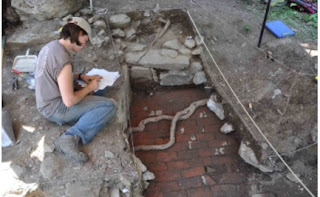 |
| The remains of the dairy |
 |
| Historic Newton board and staff tour the dig |
If you were driving past the corner of Waverley Ave. and Kenrick St. during May and June, you might have noticed some odd goings-on at the Durant-Kenrick property. At times as many as a dozen people could be seen busily digging holes (using what looked like tea spoons and pastry brushes!), writing intently in water-proof notebooks, working on ruggedized laptops balanced on the hood of a Subaru Outback, and planting tiny multicolored flags all over the place. Most baffling was the strange four-wheeled contraption they would periodically pull back and forth across the grass and muddy earth. It looked something like a cross between a squashed lunar rover and a go-cart. Who were these strange beings and what were they doing at the Durant-Kenrick House? Welcome to the world of suburban archaeology.
The busy people were staff and students from the Fiske Center for Archaeological Research at UMass Boston, and they were there on behalf of Historic Newton, helping us figure out what, if anything, lay beneath the earth at our newest acquisition. In case you didn’t know, and I certainly didn’t until a few years ago, if you’re planning to do any kind of digging or disturbing the ground on a historic site (and the Durant-Kenrick House is nothing if not historic), you need to make sure that you’re not about to inadvertently disturb buried historic treasures (Indian burial grounds? Historic foundations? An entire village?).
When I first heard of this requirement, I reacted with dismay. This would delay the project and cost money, and for what? Three years later, I now know for what. On a drizzly June day, a small group of Gore-Tex clad board members showed up to witness first-hand what the archaeologists’ painstaking excavations had revealed.
As it turned out, the squashed lunar rover was actually a sophisticated ground-penetrating radar device that had detected and mapped (with the help of the Subaru-perched laptops) all manner of underground artifacts on the site. These included the stone structure of a back-yard well, some stone footings from a large but long-gone barn, and, most spectacularly, the intricate brick floor and foundation of a rather mysterious building that would have stood adjacent or attached to the north-east corner of the house in the early 1800s.
After some research and consultation with their archaeologist colleagues, the UMass team decided that what they had uncovered was what they refer to as a “dairy.” This would have been a structure (almost certainly wooden) built on the foundation stones shown in the picture above. The floor of the dairy, comprised of tightly nested bricks, was about 1 foot or so below ground level. This arrangement helped keep the temperature inside the structure cool; the brick floor would have also helped to make the inside easy to keep clean. In the
early 19th century, the building would have had low shelves on which wooden trays or bowls would be placed for storage of milk, cream, and butter. The fact that the structure was adjacent to the house just where the kitchen was located further supports these ideas.
This discovery was both exciting and vexing. Exciting, because it exposed a new dimension of life in the 1800s. The staff at Historic Newton were and are energized by the possibilities for making this structure part of the educational experience being planned for the D-K house. Vexing, because the dairy was located precisely where a new structure connecting the historic house and the new educational wing is to be built. Modifying that plan this late in the game would mean lost time (many months) and considerable expense.
After much thoughtful debate, it was decided to disassemble the dairy stone-by-stone, after carefully marking and mapping each stone and brick, so the structure could be re-assembled elsewhere on the site at a later date. Our hope is that we will be able to re-create not just the historic foundation but also to construct a replica or facsimile of the dairy superstructure. As of this writing, the dairy foundation is still where it has been for almost 200 years, waiting patiently to tell its story to future visitors.
No comments:
Post a Comment